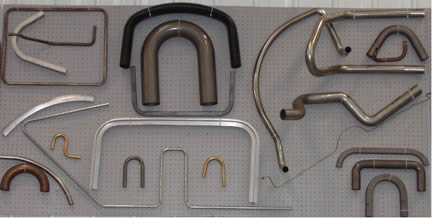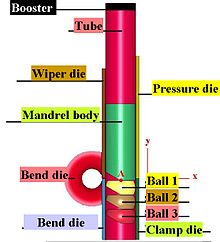| Rotary Draw Bending |
Rotary draw bending (RDB) is a precise technology, since it bends using tooling or "die sets" which have a constant center line radius (CLR), alternatively indicated as Mean Bending Radius (Rm). Rotary draw benders can be programmable to store multiple bend jobs with varying degrees of bending. Often a positioning index table (IDX) is attached to the bender allowing the operator to reproduce complex bends which can have multiple bends and differing planes. Rotary draw benders are the most popular machines for use in bending tube, pipe and solids for applications like: handrails, frames, motor vehicle roll cages, handles, lines and much more. Rotary draw benders create aesthetically pleasing bends when the right tooling is matched to the application. CNC rotary draw bending machines can be very complex and use sophisticated tooling to produce severe bends with high quality requirements. The complete tooling is required only for high-precision bending of difficult-to-bend tubes with relatively large OD/t (diameter/thickness) ratio and relatively small ratio between the mean bending radius Rm and OD.[3] The use of axial boosting either on the tube free end or on the pressure die is useful to prevent excessive thinning and collapse of the extrados of the tube. The mandrel, with or without ball with spherical links, is mostly used to prevent wrinkles and ovalization. For relatively easy bending processes (that is, as the difficulty factor BF decreases), the tooling can be progressively simplified, eliminating the need for the axial assist, the mandrel, and the wiper die (which mostly prevents wrinkling). Furthermore, in some particular cases, the standard tooling must be modified in order to meet specific requirements of the products.
|
|||




